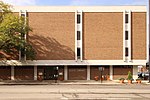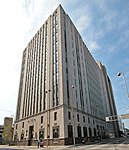Black Lives Matter street mural (Cincinnati)
2020 establishments in Ohio2020 paintings2020s muralsBlack Lives Matter artMurals in Ohio ... and 2 more
Ohio stubsPaintings in Cincinnati

A "Black Lives Matter" street mural has been painted in Cincinnati, in the U.S. state of Ohio.The mural appears on Plum Street between Eighth and Ninth streets.
Excerpt from the Wikipedia article Black Lives Matter street mural (Cincinnati) (License: CC BY-SA 3.0, Authors, Images).Black Lives Matter street mural (Cincinnati)
Plum Street, Cincinnati West End
Geographical coordinates (GPS) Address Nearby Places Show on map
Geographical coordinates (GPS)
| Latitude | Longitude |
|---|---|
| N 39.1044 ° | E -84.5188 ° |
Address
Black Lives Matter
Plum Street
45203 Cincinnati, West End
Ohio, United States
Open on Google Maps











